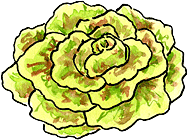Lettuce (head lettuce)

Though most types of lettuce will eventually form a head, there are some, such as iceberg and romaine, that are typically grown specifically for a tight, central head. If this is what you're after (rather than a cutting mix) here is how to do it.
Seed companies tend to divide head lettuce into several categories: crisphead, which includes iceberg and similar tight-headed varieties; bibb, Boston and butterhead, which make loose heads; and romaine, a tall lettuce with big ribs.
When deciding what type of lettuce to grow, read the seed packets or catalog descriptions carefully. Lettuce is a good cool-weather crop, so you can get started early by sowing some seeds indoors under lights, about eight weeks before the last frost. These seedlings can be planted outdoors when they are four weeks old. Cover them with garden fabric (row cover) for protection from wind and light frost. If you wish, you can direct-sow some lettuce seed right into the garden at the same time. When the seeds come up, you can distribute the plants around the garden wherever there's an empty spot.
Lettuce seeds are tiny, but when sowing them indoors, there is an easy way to plant them one at a time. Buy a piece of quarter-inch dowel and sharpen it in a pencil sharpener; you will use this like a magic wand to plant your lettuce seeds. Fill a pot or 6-pack with moist growing medium. Pour some seeds into one hand. Dip the stick in a bowl of water to moisten it and then touch a seed to pick it up. When you touch the stick to the soil surface your seed will be released, as if by magic!
When planting lettuce, don't cover the seeds with more than a dusting of soil, as they need light to germinate. Be sure to press down on the seed after planting so it is in good contact with the soil.
To get nice big heads of lettuce, plant no more than one or two plants per square foot. For maximum production, start with four plants and harvest two of them as teenagers, letting the other two grow to maturity. You can also harvest some of the outer leaves as they develop, leaving the inner head intact.
Print this Article:
Get the Dirt
Stay up to date on new articles and advice. Please fill out the information below.
